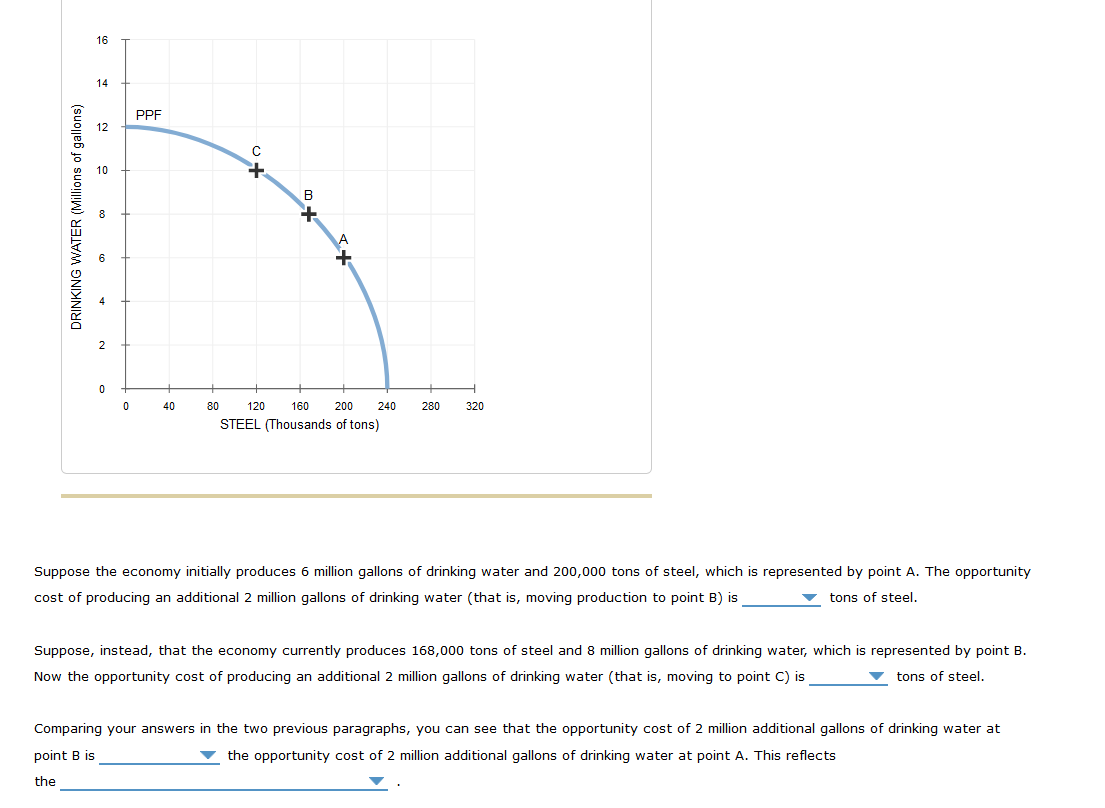The following graph shows the production possibilities frontier (PPF) of an economy that produces drinking water and steel. The black points (plus symbols) represent three possible output levels in a given month. You can select the points to see their exact coordinates. Suppose the economy initially produces 6 million gallons of drinking water and 200,000 tons of steel, which is represented by point A. The opportunity cost of producing an additional 2 million gallons of drinking water (that is, moving production to point B) is _________ (options: 24000, 32000, 40000, 48000, 60000). Suppose, instead, that the economy currently produces 168,000 tons of steel and 8 million gallons of drinking water, which is represented by point B. Now the opportunity cost of producing an additional 2 million gallons of drinking water (that is, moving to point C) is ________ (options: 24000, 32000, 40000, 48000, 60000). Comparing your answers in the two previous paragraphs, you can see that the opportunity cost of 2 million additional gallons of drinking water at point B is _________ (options: less than, equal to, greater than) the opportunity cost of 2 million additional gallons of drinking water at point A. This reflects the __________ (options: fact that resources are scarce, notion that countries can gain from trade, principle of increasing costs).
The following graph shows the production possibilities frontier (PPF) of an economy that produces drinking water and steel. The black points (plus symbols) represent three possible output levels in a given month. You can select the points to see their exact coordinates. Suppose the economy initially produces 6 million gallons of drinking water and 200,000 tons of steel, which is represented by point A. The opportunity cost of producing an additional 2 million gallons of drinking water (that is, moving production to point B) is _________ (options: 24000, 32000, 40000, 48000, 60000). Suppose, instead, that the economy currently produces 168,000 tons of steel and 8 million gallons of drinking water, which is represented by point B. Now the opportunity cost of producing an additional 2 million gallons of drinking water (that is, moving to point C) is ________ (options: 24000, 32000, 40000, 48000, 60000). Comparing your answers in the two previous paragraphs, you can see that the opportunity cost of 2 million additional gallons of drinking water at point B is _________ (options: less than, equal to, greater than) the opportunity cost of 2 million additional gallons of drinking water at point A. This reflects the __________ (options: fact that resources are scarce, notion that countries can gain from trade, principle of increasing costs).
Managerial Economics: Applications, Strategies and Tactics (MindTap Course List)
14th Edition
ISBN:9781305506381
Author:James R. McGuigan, R. Charles Moyer, Frederick H.deB. Harris
Publisher:James R. McGuigan, R. Charles Moyer, Frederick H.deB. Harris
Chapter11: Price And Output Determination: Monopoly And Dominant Firms
Section: Chapter Questions
Problem 1E
Related questions
Question
The following graph shows the production possibilities frontier (PPF ) of an economy that produces drinking water and steel. The black points (plus symbols) represent three possible output levels in a given month. You can select the points to see their exact coordinates.
Suppose the economy initially produces 6 million gallons of drinking water and 200,000 tons of steel, which is represented by point A. The opportunity cost of producing an additional 2 million gallons of drinking water (that is, moving production to point B) is _________ (options: 24000, 32000, 40000, 48000, 60000).
Suppose, instead, that the economy currently produces 168,000 tons of steel and 8 million gallons of drinking water, which is represented by point B. Now the opportunity cost of producing an additional 2 million gallons of drinking water (that is, moving to point C) is ________ (options: 24000, 32000, 40000, 48000, 60000).
Comparing your answers in the two previous paragraphs, you can see that the opportunity cost of 2 million additional gallons of drinking water at point B is _________ (options: less than, equal to, greater than) the opportunity cost of 2 million additional gallons of drinking water at point A. This reflects the __________ (options: fact that resources are scarce, notion that countries can gain from trade , principle of increasing costs).

Transcribed Image Text:16
14
PPF
12
10
B
2
40
80
120
160
200
240
280
320
STEEL (Thousands of tons)
Suppose the economy initially produces 6 million gallons of drinking water and 200,000 tons of steel, which is represented by point A. The opportunity
cost of producing an additional 2 million gallons of drinking water (that is, moving production to point B) is
tons of steel.
Suppose, instead, that the economy currently produces 168,000 tons of steel and 8 million gallons of drinking water, which is represented by point B.
Now the opportunity cost of producing an additional 2 million gallons of drinking water (that is, moving to point C) is
tons of steel.
Comparing your answers in the two previous paragraphs, you can see that the opportunity cost of 2 million additional gallons of drinking water at
point B is
▼ the opportunity cost of 2 million additional gallons of drinking water at point A. This reflects
the
DRINKING WATER (Millions of gallons)
Expert Solution
This question has been solved!
Explore an expertly crafted, step-by-step solution for a thorough understanding of key concepts.
This is a popular solution!
Includes step-by-step video
Trending now
This is a popular solution!
Learn your way
Includes step-by-step video
Step by step
Solved in 3 steps

Knowledge Booster
Learn more about
Need a deep-dive on the concept behind this application? Look no further. Learn more about this topic, economics and related others by exploring similar questions and additional content below.Recommended textbooks for you

Managerial Economics: Applications, Strategies an…
Economics
ISBN:
9781305506381
Author:
James R. McGuigan, R. Charles Moyer, Frederick H.deB. Harris
Publisher:
Cengage Learning

Managerial Economics: Applications, Strategies an…
Economics
ISBN:
9781305506381
Author:
James R. McGuigan, R. Charles Moyer, Frederick H.deB. Harris
Publisher:
Cengage Learning